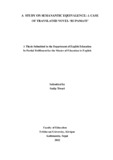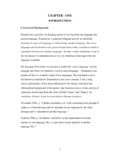Please use this identifier to cite or link to this item:
https://elibrary.tucl.edu.np/handle/123456789/1575Full metadata record
| DC Field | Value | Language |
|---|---|---|
| dc.contributor.author | Tiwari, Sudip | |
| dc.date.accessioned | 2018-12-10T07:33:53Z | |
| dc.date.accessioned | 2021-07-23T02:43:42Z | - |
| dc.date.available | 2018-12-10T07:33:53Z | |
| dc.date.available | 2021-07-23T02:43:42Z | - |
| dc.date.issued | 2012 | |
| dc.identifier.uri | http://elibrary.tucl.edu.np/handle/123456789/1575 | - |
| dc.description.abstract | This research work entitled A study on Semantic Equivalence: A Case of Translated Novel ‘Rupamati’ has been carried out to analyze the semantic equivalence through sentence level between the source text (henceforth: ST) and translated text (henceforth: TT). The source of data consists of the original Nepali text and its translated English version Rupamati. The ST and TT are deemed as sample universe. From this, the selection of the sample size consists of sixty pairs of sentences from both texts. For sampling procedure, the random sampling method has been applied. The different tools such as observation, checklist and syntactic structure and semantic analysis have been used for the data analysis. It is found that the translator has carefully chosen different lexical item in TT to fulfill semantic equivalence. Sometimes, the translator himself gets derailed and the work of translation cannot meet the semantic equivalence. The translator has sometimes used extra lexical item which is not found in ST. It is found that, the translator has split the syntactic structure of the compound sentence into two in TT. It is also found that the translator has mostly omitted exclamatory marker in TT whereas the ST exclamatory sentences contain it. This thesis comprises four chapters. Chapter one deals with general introduction, review of related literature, objectives of the study and significance of the study. Chapter two deals with method and procedure adopted to carry out the research. It contains information on the source of data, sampling procedures, tools, process of data collection and limitation of the study. Chapter three consists of the analysis and interpretation of the data. Chapter four deals with the major findings of the study on the basis of the analysis and interpretation of the collected data. It also deals with some recommendations made, based on the major findings of the study. Finally, chapter four is followed by the references and appendices. | en_US |
| dc.language.iso | de | en_US |
| dc.subject | Semantic Equivalence | en_US |
| dc.subject | Translated Novel | en_US |
| dc.subject | Rupamati | en_US |
| dc.subject | Gaps in Translation | en_US |
| dc.title | A Study on Semanantic Equivalence: A Case of Translated Novel ‘Rupamati’ | en_US |
| dc.type | Thesis | en_US |
| Appears in Collections: | English Language Education | |
Files in This Item:
| File | Description | Size | Format | |
|---|---|---|---|---|
| Topic.pdf | 81.52 kB | Adobe PDF |  View/Open | |
| sudip thesis.pdf | 463.55 kB | Adobe PDF |  View/Open |
Items in DSpace are protected by copyright, with all rights reserved, unless otherwise indicated.
